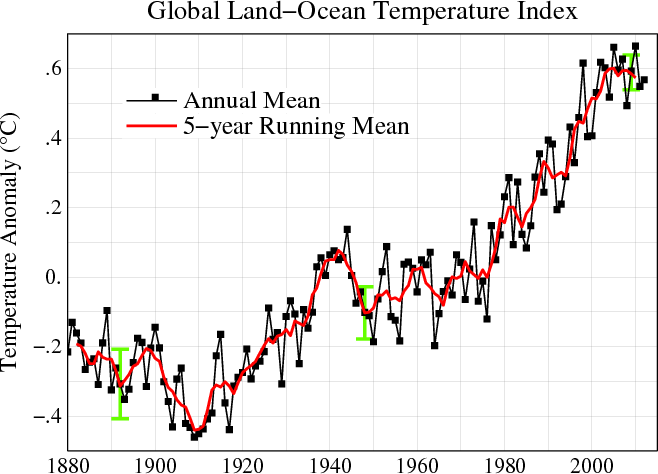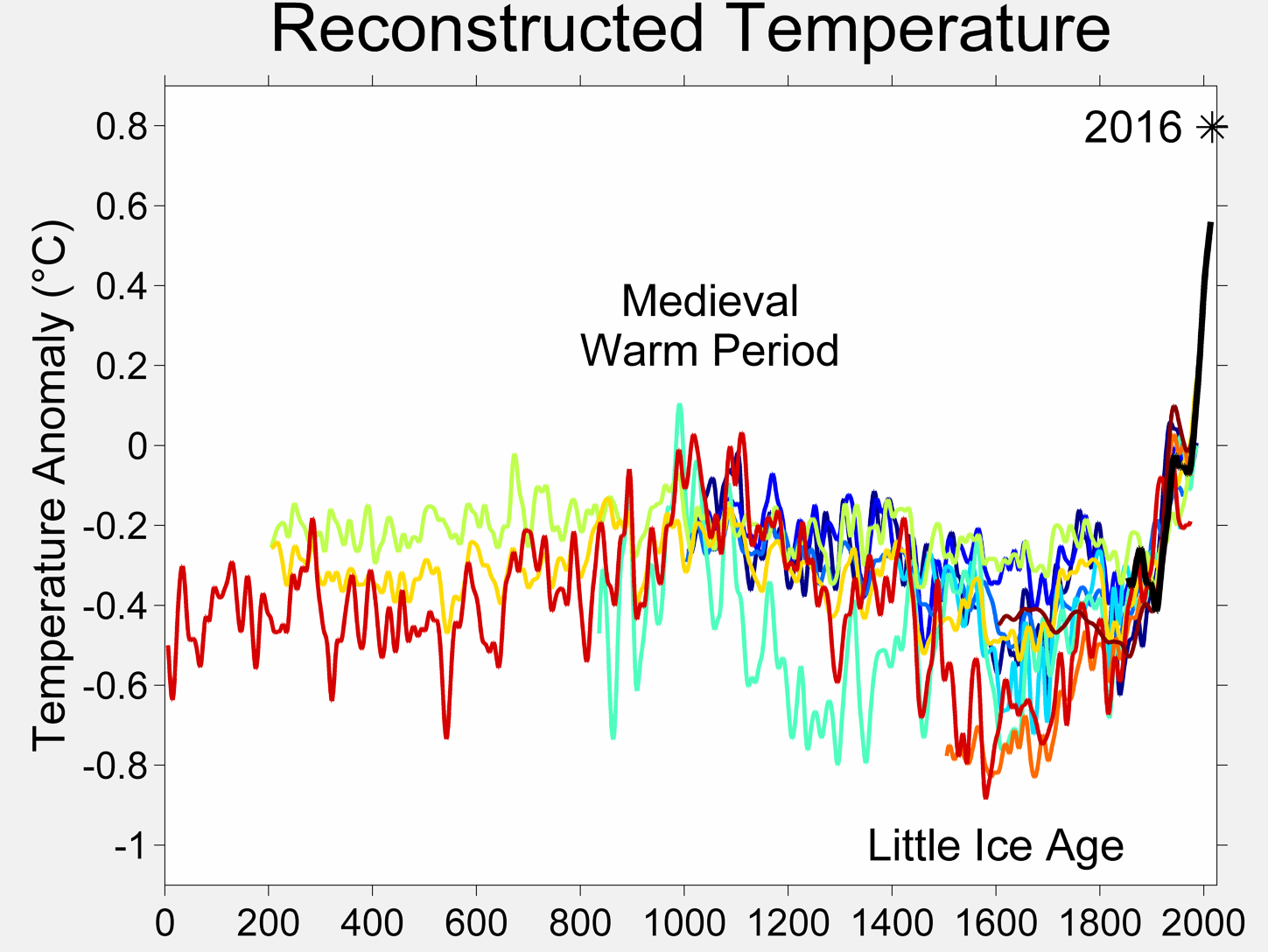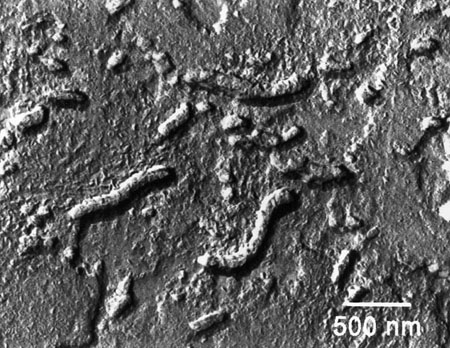In 1983 James Lovelock and Andrew Watson created a computer simulation called "Daisyworld". The premise was an ultra-simplified ecosystem, a world inhabited by only two species, white daisies and black daisies. Affecting this world's climate was the single factor of its sun's heat. The high-albedo white daisies reflect sunlight and the low-albedo black daisies absorb sunlight. The "monkey wrench" in the system is that the sun is actually slowly becoming hotter.
So, as the simulation begins, the sun's radiation is too small to germinate either the white or black daisies, but the surface of the planet is covered with evenly distributed seeds of both black and white daisies. As the sun becomes hotter and the world heats up, eventually the world becomes warm enough for the black daisies to germinate and bloom. The black flowers absorb the sun's heat, causing the world to warm even more rapidly, until it is warm enough for the white daisies to also germinate and bloom. The white flowers reflect the sunlight and begin to lower the world's temperature. As the sun continues to heat up to a level which is uncomfortable for the daisies, the white flowers, which are better able to cool themselves, out-compete the black flowers. The greater the surface-area of the world that is covered by white daisies, the greater the cooling effect of the white flowers. In this way, the white and black flowers work in tandem to regulate the temperature to a level which is comfortable for all daisies. Eventually the sun heats up beyond the ability of the white daisies to regulate it, and all of the daisies die. If, however, the sun's heat remains more or less constant, the populations of white and black daisies will equilibrate in such a way as to maintain an optimum climate for the daisies. In this way, rather than naturally selecting to adapt to the environment, the daisies modify their environment to fit their own needs.
Later generations of the Daisyworld program added many more layers of complexity (atmosphere, herbivorous and carnivorous animals, etc), but each iteration of complexity actually increases the world's ability to self-regulate.
Here is a diagram of this first Daisyworld test, in 1983:
It is serendipitous, only, that this model happens to address global warming. Lovelock and Watson could have chosen any number of variables, and the problem of anthropogenic climate change was only vaguely understood at the time. Nonetheless, it serves admirably to illustrate a possible solution to the current global warming crisis.
There are four things we know for certain about the current global warming situation.
1) It is happening, and it is the largest and fastest increase in global temperatures since eukaryotic life has existed on earth.
2) It is happening mostly as the result of human activity, especially the combination of the burning of fossil fuels and deforestation.
3) If left unmitigated, it is the single most likely cause of the extinction of the human species. If current trends continue, earth will be uninhabitable by human life by the end of this century. More importantly, there is a very real possibility that anthropogenic global warming will (if it has not done so already) trigger a runaway climatological feedback-loop which will continue to increase global temperatures long after humans are extinct. The worst-case scenario, which is unfortunately quite plausible, would result in earth becoming a hellishly hot Venus-like world devoid of all liquid water and all life, within about 600 years.
4) There are three foreseeable outcomes for the human population from this; mitigation, outmigration or extinction.
This blog has spent a lot of time exploring the possibility of outmigration, and I do believe that this is a critical step to ensure the survival of our species, and other terrestrial species. However, in the very short amount of time we have before this planet is no longer habitable, we would only be able to successfully evacuate a tiny fraction of our population. In order for the majority of humans to survive, we must directly and immediately mitigate the increase in global temperatures.
The good news is, we can. And we don't have to wait for governments or corporations to take the lead; we can do it ourselves, right now, easily and inexpensively.
As a very quick summary, the problem is this. Short-wave radiation from the sun (insolation, with an "o") enters the atmosphere, heating both the atmosphere and the earth's surface. Some of this is reflected directly back into space, both by the earth's surface or by clouds. Some of it is re-radiated as long-wave radiation from the earth and air back into space as well. Some of it, however, is trapped in the atmosphere by greenhouse gasses ("insulation", with a "u") such as carbon dioxide, water vapor and methane. For a very long time, this insolation/insulation cycle was in a state of equilibrium. Now, however, the combination of an extraordinary amount of CO2 pumped into the atmosphere since the beginning of the industrial revolution by the burning of fossil fuels, and the diminished ability of trees to scrub CO2 out of the atmosphere due to deforestation, has created an overabundance of CO2 in our atmosphere. This increases the greenhouse effect, which raises temperatures, which evaporates water which increases the greenhouse effect even more which further raises temperatures, which kills off trees which reduces the ability of forests to scrub CO2 out of the system which increases greenhouse CO2 which increases temperatures, etc.
Freeman Dyson, the same brilliant mind who invented a starship to reach Alpha Centauri in 88 years time back in 1957 (the Orion nuclear-pulse starship, I've written quite a bit about it in this blog) has proposed a simple and elegant solution to this problem.
In order to stop catastrophic global warming, we simply need to plant one trillion trees.
Right now.
Really.
Yes, it sounds like a lot. But we have over seven billion people on the planet. That works out to just under 143 trees per person. If every man, woman and child on planet earth were to plant just two trees every five days for one year, even with no reduction in our usage of fossil fuels we would actually be in some danger of shocking the climate into a mini ice-age.
Our planet has a remarkable ability to self-regulate its ecosystems. But it only works if all the "daisies" are there to do their part of the regulating.
Yes, it would actually be more helpful to plant all 143 trees at an optimal time for planting them. You can start them from seeds, just pick up a couple handfuls of seeds of some kind of tree which is indigenous to your area, and plant them in an place that they are likely to grow. If you are ridiculously slow about it, it might take you a couple of hours to do so. Then, walk away and forget about them. This isn't difficult. Entire forests have been successfully planted by a single individual.
Of course, the very best time to plant a tree is twenty years ago. Barring that, "today" is an awfully good second best.
Happy Arbor Day, whenever that happens to be where you are.










